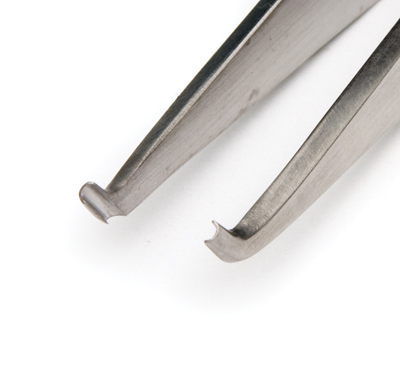

Forceps
Tweezer, forceps, needle pullers – here's some information on selecting the proper forceps for your application.
Choosing Surgical Forceps
 Surgical forceps may be broadly divided into two categories, thumb forceps (frequently called tweezers or pinning forceps) and ring forceps (also called hemostats, hemostatic forceps and locking forceps).
Surgical forceps may be broadly divided into two categories, thumb forceps (frequently called tweezers or pinning forceps) and ring forceps (also called hemostats, hemostatic forceps and locking forceps).
Thumb forceps are spring forceps used by compression between your thumb and forefinger and are used for grasping, holding or manipulating body tissue. They are non-ratchet style. For example, you could use thumb forceps to hold or move tissue during surgery or to move dressings.
Hemostatic forceps are hinged forceps that look more like scissors. Hinged forceps may come with or without a "lock" for clamping.
Thumb forceps are available with a variety of tips. The tips may be flat, serrated, cupped, ringed, grooved, diamond dusted or have teeth. The tips may also be straight, curved or angled. See the images below. Serrated tweezers (thumb forceps) are designed for use with tissues. The serrations or teeth actually cause less damage than flat forceps, because it requires less pressure to maintain a firm grip. Use smooth or cross-hatched forceps for removing sutures, moving dressing or other drapes.
Commonly used thumb forceps include Adson forceps, Iris forceps and Foester forceps.




Locking forceps may be called clamps and are used to securely hold tissue. When they are used to control blood flow, they are called hemostats. When used to grasp and manipulate needles, they are called needle holders.

Thumb Forceps Stainless Steel
Tweezer, forceps, needle pullers – here's some information on selecting the pr...

Thumb Forceps Titanium
Tweezer, forceps, needle pullers – here's some information on selecting the pr...

Tissue Forceps Stainless Steel
Tissue forceps are used in surgical procedures for grasping tissue. Often, the tips ...

Tissue Forceps Titanium
Tissue forceps are used in surgical procedures for grasping tissue. Often, the tips ...




Request
Catalogue
Chat
Print